
Sweating Treatment Page Menu: 1 2 3 4 5 <<First
Sweating Humoral Treatment in the Golden Age of Piracy, Page 5
Sweating Procedure
While sweating is not typically viewed as a medical procedure in and of itself, the procedure that was employed can be assembled from comments the period authors made in explaining their cures for various health problems. At its core, it seems quite simple - the patient is warmed either by medicines or external methods and he sweats. The details are a little more complex, although they vary from procedure to procedure. Still, the essence of each scheme basically follows the same template.
This section takes a brief look at some of the practical theory behind sweating, the proper time of day for sweating, the medicines used, the actual procedure followed and the duration of sweating once it has begun.
Practical Theory
Sweating was primarily within the purview of physicians, so explanations of when and how to sweat a patient sometimes came packaged with bits of 'practical' theory. Let's briefly look at some of practical theories which were relevant to the sweating procedure.
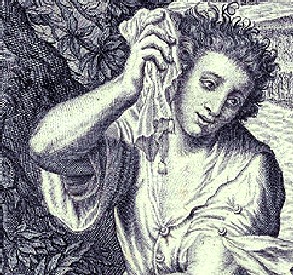
Artist:
Peter Candid (1699)
Physician Thomas Sydenham favored sweating in plague- and typhus-based fevers because it resulted in "the dissipation of the Pestilential Ferment [causing the illness] by Sweat"1. The type of patient was an important factor in his recommendation for how to sweat them. Sydenham explained that "young Men of a hot Constitution, sweat difficultly; and in such, the more you endeavour to force Sweat by strong Diaphoreticks, and by heaping on a great many Clothes, so much the more are they in Danger of falling into a Phrensie"2.
Sydenham also warned that for patients who were "easie to sweat, if it be stop'd too soon, viz. before the morbifick [disease-causing] Matter is wholly dispers’d" the disease would run the risk of not being fully ejected by sweating. This allowed it to remain in the patient's body, resulting in "the dreadful Enemy being again taken in, [and] a commotion is stirred up in the Blood, whereby the Purple Spots, the Tokens of a sudden Death, are often driven out"3.
The condition of the patient was also a factor in how they were to be dosed with sweating medicines. Sea surgeon John Moyle recommended when treating tropical or continual fevers that "your Dose be ordered more or less according to the strength of the Patient"4.
The state of the disease also impacted the treatments used. When treating a pox, Moyle explained that if it were "recent and mild, it may be Cured by
Purging and Sweating But if it be inveterate and stubborn, it must be Cured by Salivation and Sweating."5 (Sweating was to be used regardless, it was only the other humoral treatments that varied.) Sydenham said of the pox, "I have found by
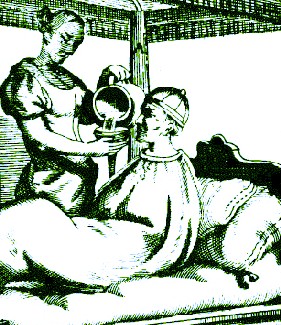
Sweating a Patient in Bed, From Armamentarum
Chirurgiae
Appendix, By Johannes Scultetus (1671)
Experience, common Sweats do as much good in this Disease, as a Decoction of the Woods [guaiacum and sassafras]"6. From this it can be seen that the means of causing a sweat in the pox was irrelevant; anything that could cause sweating would be useful.
1,2,3 Thomas Sydenham, The Whole Works of Dr. Thomas Sydenham, 3rd ed, 1701, p. 69; 4 John Moyle, The Sea Chirurgeon, 1693, p. 158; 5 Moyle, p. 243;6 Sydenham, p. 252
Time of Day
Some authors suggested there was a proper time of day to sweat a patient. Physician John Pechey said, "The most convenient Time for sweating is the Morning, and that on an empty Stomach; for then the Sweat comes out more easily and plentifully."1
Fellow physician Joannes Sintelaer agreed with Pechey, explaining that the practitioner should "let him [the patient] sweat thus soundly every Morning and Evening (or at least as often as his Strength will admit of) till you judge him to be perfectly cured"2. In one of his procedures using sweating for a patient with the pox, Sintelaer administered "two Drachms [of his sweating powder] every Morning early, in four spoonfulls"3.
However, these two authors are the exceptions to the more general trend among the golden age of piracy era authors who doesn't suggest that any particular time of day was more or less conducive to sweating. Sea surgeon John Moyle does suggest when treating malarial fevers, "at night when he [the patient] turns in, give him of Aqua febrifuga [fever water - a distilled water from Johannes Schroeder containing several ingredients which include the sudorific spirit of vitriol aka. sulfuric acid] {2 or 3 ounces}, and sweat him upon it."4 However, this suggestion does not imply the rigor indicated by Pechey and Sintelaer.
1 John Pechey, A Plain Introduction to the Art of Physick, 1697, p. 166; 2 Joannes Sintelaer, The Scourge of Venus and Mercury, 2nd ed,, 1709, p. 255; 3 Sintelaer, p. 242; 4 John Moyle, Abstractum Chirurgæ Marinæ, 1686, p. 122;
Medicines
Most surgeons and physicians began a sweating treatment by giving the patient a sudorific or diaphoretic medicine. Different authors favored different medicines. Here you will find a listing of medicines suggested by the period authors under study for causing sweat. More information about 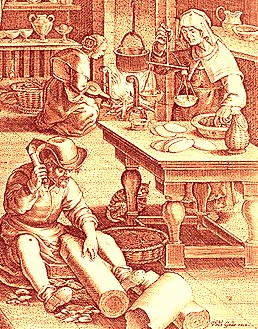
Artist: Jan van der Straet
Preparing Guaiacum, Hyacum et Lues Venera (16th c.)
these medicines can be found on the previous page in the section 'Healing By Artificial Sweat - Surgeon Recommended Medicines.'
While sea surgeon John Moyle listed one of the widest varieties of sudorific and diaphoretic medicines from the authors under study, he often resorted to using 'burnt wine' (brandy) as his sweating agent when explaining specific procedures.1
Sea surgeon John Woodall doesn't actually have a specific procedure for sweating in his book, although he suggests several medicines were good for this purpose when discussing medicines. When discussing each medicine, he lists the illnesses where he felt it was most appropriate. For example, Woodall suggests that China roots2, guaiacum3 and sarsiparilla4 were good for sweating a patient with the pox, salt of absinthe5 and antimony6 for patients with general fevers and water of carduus benedictus for malarial fevers7.
Physician Ambroise Paré treated palsy [paralysis with involuntary twitching of a member] using wine combined with a variety of medicinal herbs which included the diaphoretic herbs absinthe and guaiacum. 8 He prescribed sweat-inducing mercury in the pox9 and opiates in the plague10.
In Joannes Sintelaer's book on treating the pox, he advised the use of a variety of medicines to encourage sweating, including guaiacum11, brandy12, China roots, sarsaparilla, sassafras13, and antimony14.
Sintelaer also provides receipts (recipes) for two different compound medicines of his own devising - one a liquid consistency and another a powder - in his treatment of the pox. 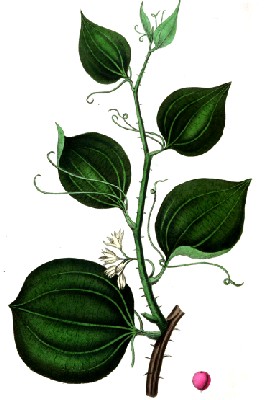
Sarsaparilla Smilax, From Medicinal Plants of the
London,
Edinburgh and Dublin Pharmacopoeias, Vol. 3 (1837)
Both contain the sweating herb sarsaparilla and the liquid medicine incorporates sassafras:
Rec[eipt]. Sarsaparilla, 3 Ounces.
Sassafras, an Ounce and half.
Anis[eeds]. half an Ounce.
Uvar. Passul. [raisins] 4 Ounces.
Liquirit[ue - licorice]. 1 Ounce
Aq. commun. [common water] 12 Pints.
Let this be boil'd to the Consumption of half the Quantity, and the Patient may drink of it, as often and as much as he can.…Rec[eipt]. Sarsaparilla, 2 Ounces.
Fol. Senn. [senna leaves] 1 Ounce.
Rad. Polypod[ium - roots of polypodium]. Half an Ounce.
Hermodactylor [Irises, likely the root] 3 Ounces.
Sacchar. alb. [white sugar] half an Ounce.
F. Pulvis. [make into a powder]Let all these Ingredients be beaten to an almost impalpable Powder, then mix them well together, and keep this Composition15
In his regimen for sweating patients with the pox, John Moyle also listed two specifics he created. These contain the sweating agents opium (in theriac concoctions), guaiacum, antimony and warm posset drink.16 (He certainly covered all his bases.) Moyle recommend a much simpler compound medicine for fevers, which contained different types of theriac (or treacle),which was mixed with his old standby, brandy.17
1 For examples, see John Moyle, Abstractum Chirurgæ Marinæ, 1686, p. 114 and Moyle, The Sea Chirurgeon, 1693, p. 100, 1567& 238; 2 John Woodall, the surgions mate, 1617, p. 97; 3 Woodall, p. p. 98; 4 Woodall, p. p. 286; 5 Woodall, p. p. 111-2; 6 Woodall, p. p. 58 (erroneously shown as 44); 7 Ambroise Paré, The Workes of that Famous Chirurgion Ambrose Parey, 1649, p. 260; 8 Paré, p. 473; 9 Paré, p. 540; 11 Joannes Sintelaer, The Scourge of Venus and Mercury, 2nd ed,, 1709, p. 235; 12 Sintelaer, p. 230; 13 Sintelaer, p. 236; 14 Sintelaer, p. 237; 15 Sintelaer, p. 242-3; 16 Moyle, Chirurgeon, p. 144; 17 Moyle, Chirurgeon, p. 157-8
Procedure
Although the procedure for sweating a patient varied depending on the health problem being addressed and the author who wrote about it, there is a definite pattern to the regular sweating treatment.
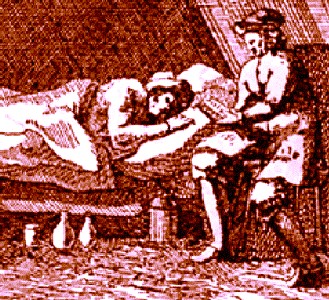
From The Perfect Soldier Teutsche, by Hans Friedrich Fleming (1726)
Joannes Sintelaer instructed, "Not long after the Patient has taken this Dose [of sudorific medicine], you must cover him very well with Blankets, or other Bed-cloaths [sheets, blankets and the like], to make him Sweat soundly"1.
Sea surgeon John Moyle agreed with covering the patient warmly; In treating tropical and continual fevers, he said after administering a sudorific, the patient should be "wrapped up warm (especially his Head bound with a warm Napkin) then let him lye until he begins to Sweat"2.
Physician Thomas Sydenham also strongly advised "that a piece of Flannel be bound to the fore-part of his Head; and indeed this covering of the Head conduces more to the procuring sweat than any one would easily imagine."3
Moyle gives a detailed description of how to make the best use an enclosed room on a ship to sweat a patient with the pox.
Let the Cabbin be made exceeding warm, as I advised before, and let the Man be laid as for to sweat, and give him only a draught of his Dyet-drink: and apply quart bottles filled with hot water (and wrapt in Clothes) to his Feet, and at his Back and Head, so will he fall to sweating powerfully; but let him have warm Napkins in the bed with him to wipe himself, and have a care that he catch not cold; afterward, but cool by degrees. And in the time he sweats (which must be an hour at least) you must give him several draughts of his Dyet-drink warm (for now it doth most good)4
Moyle gives a recipe for the 'Dyet-drink' in his book, calling it 'the Sudorifick Dyet-Drink.'
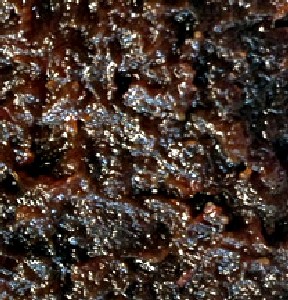
Passular or Raisin Paste - Probably Looking Just
About as
Appetizing as You Thought It Might
Its ingredients includes several sudorific and diaphoretic medicines including guaiacum, sarsaparilla and China roots. The other herbs used are saxifrage and licorice roots, fennel seeds and passular - a paste made of raisins.5
Once the patient began to sweat, Moyle said to "give him a draught of warm Posset-drink, and let him Sweat well, having a warm Cloth in the Bed with him to wipe off the Sweat withal."6 He also advised the surgeon to
Embrocate the Temples with a little Ointment of Roses [probably oil of roses]. And let there be as little noise as possible, (a thing very hard to be observed in a Ship) and let not the light offend, but expose him by all means to rest; if you see he sleeps, and perceive a moist warmth, or breathing Sweat upon him in his sleep, then 'tis a good sign he will recover.7
While many sweating procedures began with the administration of a sudorific or diaphoretic medicine, not all did. French surgeon Ambroise Paré recommended several alternate ways to provoke a sweat. In treating the plague, Paré recommended 'moderate walking' (relying on exercise to raise a sweat) after which "the patient must bee put Warm to bed, and covered with manie cloaths."8 In his sweating remedy for the pox, Paré further notes that "strong exercises do good, as the carrying of heavie burdens even until they sweat" as well as "swimming in cold water"9.
In place of clothes, Paré advised the surgeon that he could instead "use bladders or spunges, or hot bricks for the same purpose; certainly a decoction of millet; figs and raisons, with som sugar, causeth sweat powerfully."10
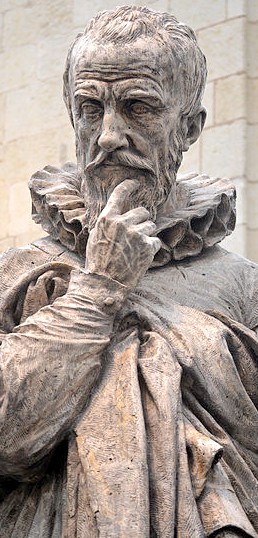
Artist: David d'Angers, Photo: Selby May
Ambroise Paré Thinking
Similar to Moyle, he suggested the use of warm bricks or tiles on the feet and pig's bladders full of hot water placed by the groin and armpits, noting that they "evacuate the humors in the fever, and also to drive forth the malignity in the pestilence, although everie sweat bring's not forth the fruit of health."11
Paré also noted that it was not "amiss whil'st the patient is covered in all other parts of the bodie, and sweat's, to fan his face, for thus the native heat is kept in and so strengthned, and fainting hindred, and a greater excrection of excrementitious humors caused."12
Paré advised, "The patient ought not to sweat with a full stomach; for so the heat is called away from performing the office of concoction [combining of the humors so they could be sweat out]"14. John Moyle echoes this sentiment in his treatment of the pox, warning the surgeon to "sweat not upon a full Stomach"15.
Unlike Moyle, he warned that the patient "must not sleep when hee is in his sweat; lest the malignitie go inwardly with the heat and spirits unto the principal parts"13. To prevent the patient from sleeping, Paré recommended "hard rubbing, and bands tied about the extreme parts of his bodie, and with much nois of those that are about him" along with squirting castoreum, tart vinegar and ethanol (aqua vitæ) in the patient's nostrils!When treating the pox, Paré adds another, rather involved warning: the patient "must abstain from wine, unless it be weak and astringent; and hee must not onely eschue familiaritie with women, but their verie pictures, and all things which may call them to his remembrance, especially if hee love them dearly"16. Thomas Sydenham gives a similar prohibition of alcohol when sweating a patient, ordering that 'cold beer be carefully avoided'. This may be due to the chilling effect as much as anything else because he goes on to recommend the patient stick to "all Drinks are somewhat hot."17
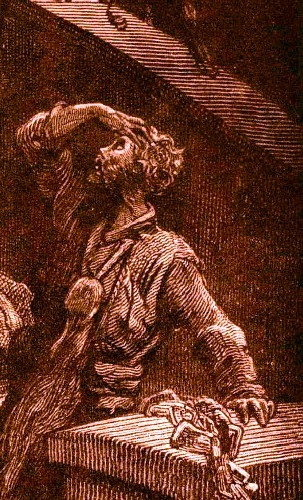
Artist: Gustav Doré
From The Rime of the Ancient Mariner, #23 (1866)
Sydenham also adds an unusual sounding requirement:
I strictly forbid that the Patient should be any way cleansed, neither indeed do I permit that the Shirt, how moist or foul soever it be, should be changed within twenty four hours from the end of the Sweat; which I would have observ'd with the greatest Caution18
In addition, he later notes that "the Cloaths [must] dry of themselves on the Body"19.
Sydenham has a very particular reason for this. He feels that if the clothes are removed during the sweating procedure, the patient will get cold and the sweat will break prematurely. As a result, "the violence of the Symptoms soon returns, and the Health of the Patient is left very uncertain, which a longer continuance of the Sweat would have put out of danger."20
Moyle is far more lax about this, simply suggesting "when you believe he [the patient] hath Sweat sufficiently, remove the Clothes off by degrees, and being grown moderately cool, let him have a warm Shift put on, and another warm Cap on his Head, and give him a little warm Chicken-Broth, or Water-Grewel with Currans, to Eat."21
Sydenham also provides a simple, stripped-down version of the sweating procedure. It is designed for use in treating tertian malaria "in poor People, who are not able to bear the Charge of a long Process." It reads: "Take of Virginian Snakeweed finely powdered one Scruple, of white Wine three Ounces; mingle them, let the Sick take it two hours before the [malarial] Fit, and being well covered with Cloaths, let him Sweat three or four hours, and let it be repeated twice, when the Fit approaches."22 It almost makes it sound as if the convoluted procedure is as much to impress the wealthy patient as it is to cure them.
1 Joannes Sintelaer, The Scourge of Venus and Mercury, 2nd ed,, 1709, p. 243; 2 John Moyle, The Sea Chirurgeon, 1693, p. 159; 3 Thomas Sydenham, The Whole Works of Dr. Thomas Sydenham, 3rd ed, 1701, p. 73; 4 Moyle, Chirurgeon, p. 152-3; 5 Moyle, Chirurgeon, p. 152; 6 Moyle, Chirurgeon, p. 159; 7 Moyle, Chirurgeon, p. 165; 8 Ambroise Paré, The Workes of that Famous Chirurgion Ambrose Parey, 1649, p. 555; 9 Paré, p. 478; 10 Paré, p. 492-3; 11 Paré, p. 555; 12 Paré, p. 493; 13,14 Paré, p. 556; 15 Moyle, Chirurgeon, p. 145; 16 Pare, p. 478; 17 Sydenham, p. 75; 18 Sydenham, p. 74; 19 Sydenham, p. 75; 20 Sydenham, p. 74; 21 Moyle, Chirurgeon, p. 159; 22 Sydenham, p. 233
Duration
The number of times sweating was used in one session and duration of sweating over the life of the illness varied by author, type of illness and how well the patient could stand the procedure.
With regard to how many times a patient should be sweated in a single session for the pox, Joannes Sintelaer says "not to neglect to sweat your Patient two or three times, according as you find the Circumstances of the Case require"1 For treating the pox, Moyle's sweating sessions are to be "an hour, or an hour and half each time"2.
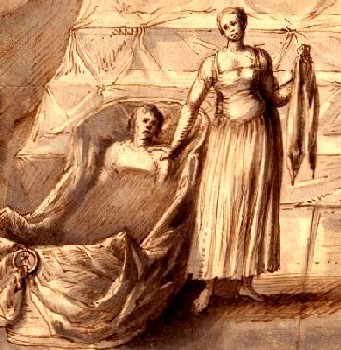
From Badstuga Svensk Nordisk Familjebok (19thc)
The duration of a sweating procedure also varies somewhat, with suggestions running between 1 day and 6 weeks.
Joannes Sintelaer starts his discussion about the duration of using sweating to treat the pox by quoting a Dr. Jo. Bapt. Pinkett. "You must continue the same Course for Nine Days successively, unless you should find your Patient reduced to so weak a Condition as not to be able to undergo it every Day, in which case you must allow him now and then a days interval, as you find there is occasion to recover his Strength a little"3.
Sintelaer does advise that "'tis not improbable, but that it [Dr. Pinkett's procedure] may be used with no small probability of Success in a fresh Pox or Maiden Pox... but yet with this Proviso, that it ought to be continued longer than 9 Days"4.
Further on in his text, Sintelaer provides more specific suggestions, noting that "most commonly the Sudorifick Course is finish'd in four or five Weeks time, but there is a great Difference betwixt the various Degrees and Symptoms of one and the same Disease, but above all in the Cure of the inveterate Pox"5. Thus, while Sintelaer provides no definite recommendation on the duration of sweating in the pox, his suggestions vary from 9 days to 5 weeks, leaning more toward the latter.
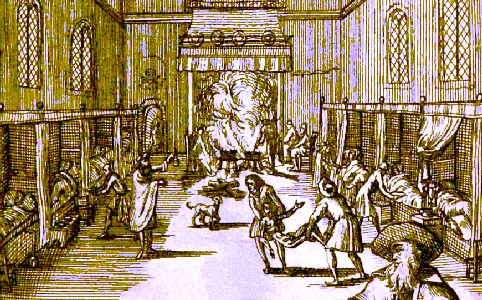
Ward for Treating the Pox, From De Spaanse Pok-Meeste, by David Abercromby (1691)
For plague- and typhus-based fevers, Thomas Sydenham orders "that the Sweat should be continued for the space of a natural Day" after which he recommends a day of sage-based posset drink and then a purge of the patient.6
In treating the pox, John Moyle provides a fairly specific regimen for sweating. The patient is to be sweat every other day "for at least five times, and then twice a week whilst the Dyet-drink is taken.”7 On the off days, the patient is sometimes given time to rest and recuperate his strength. Then the surgeon is to resort
to Purging again as before; letting him take [purging medicines] but three times each other day; and then after a day between sweat again twice; then observing the same space of time, purge once; and then after a day more sweat once.
By this time thirty dayes will be expired, and you will find the Patient much better (if not well) you will then see whether this way will do it or no; and if it prevails, then (if he is not quite well) you may persevere longer in this method, until he is well. If it be six Weeks, or two Months time, you need not think much [of it].8
1 Joannes Sintelaer, The Scourge of Venus and Mercury, 2nd ed,, 1709, p. 240; 2 John Moyle, The Sea Chirurgeon, 1693, p. 145; 3 Sintelaer, p. 243; 4 Sintelaer, p. 244; 5 Sintelaer, p. 259; 6 Thomas Sydenham, The Whole Works of Dr. Thomas Sydenham, 3rd ed, 1701, p. 74-5; 7 Moyle, Sea Chirurgeon, p. 153; 8 Moyle, Sea Chirurgeon, p. 145-6
Bathing Procedures Used to Sweat
There were a couple of authors who advised bathing procedures to encourage sweating during the golden age of piracy. Since these deviate from the standard procedure of warming the patient by medicines and/or externally applied warming agents and then letting them sweat in bed, it seemed appropriate to give them their own section at the end of the article. One is suggested by Ambroise Paré and the other two by sea surgeon John Woodall.
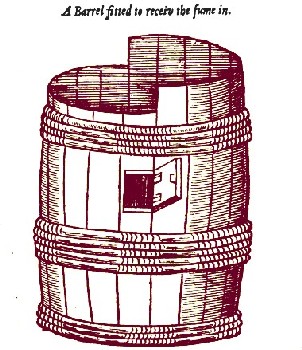
Paré's 'Tub' From The Workes of that Famous
Chirurgion Ambrose Parey, p. 480 (1649)
Paré's procedure is used to treat palsy - paralysis, particularly of limbs, with involuntary twitching. He puts his patient "into a bathing-tub, which is veiled or covered over"1. This is done so that the patient can breath in vapors from a rather complex concoction. This recipe contains leaves of sage, lavender, bay, absinthe, Blitum bonus-henricus, angelica and rue; flowers of chamomile, melilot, dill and cloves; bay and juniper berries and cloves, all mixed together in strong water and white wine. "The patient shall keep himself in that Bathing-tub [breathing in the fumes of this mixture], as long as his strength will give him leave, then let him be put into his bed well covered, where he shall sweat again, be dried and rest."2
Woodall's first bath is used to treat the gout, rheumes and skin irritations of patients at sea. He creates this liquid used by boiling sea salt "in the strongest beere to the consumption of three parts of the same beere and being made salt as Brine"3. He then orders the surgeon to "make a bath of [this concoction]... as warme as they [the patient] can possible indure it, sit in it and sweat therein, and after go to a warm bed and sweat againe, and doing so sundry times, they shall feele helpe thereby."4
Woodall also recommends a bathing procedure for treating limbs swollen from scurvy. He begins by bathing the swollen part in a moderately weak lixivium (lye), "(for too sharp of the ashes, will over heat, yea & excoriate [take off the top layer of skin])"5. Woodall then makes a medicinal by boiling a variety of herbs in water, many of them the same as Paré's herbs for treating the palsy. These include "Camomile, Mellilote, Dill, Wormewood [absinthe], [lemon] Balme, Rosemary, Time, Sage, Bay-leaves, Bay-berries, Juniper berries, Anis-seede, Fennell, Coriander, Carraway, [and] Dill seedes"6. The surgeon is then to take "stupes [folded clothes] of woollen or linnen clothes wet therein or put the ingredients into bagges after the decoction is made with them, and the place well fomented [bathed] therewith, and so laid to sweat with some of the hearbes in the same bagges well wrung out and hot applied, till the next dressing."7
1,2 Ambroise Paré, The Workes of that Famous Chirurgion Ambrose Parey, 1649, p. 260; 3 John Woodall, the surgions mate, 1617, p. 275; 4 Woodall, p. 275-6; 5,6,7 Woodall, p. 192

